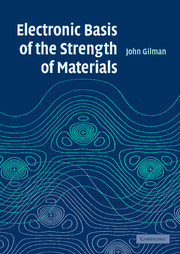Book contents
- Frontmatter
- Contents
- Preface
- Section I Introduction
- Section II Elements of solid mechanics
- 1 Nature of elastic stiffness
- 2 Generalized stress
- 3 Generalized strain
- 4 Elastic coefficients
- Section III Elements of electron mechanics
- Section IV Elastic stiffness
- Section V Plastic strength
- Section VI Fracture resistance
- Index
1 - Nature of elastic stiffness
Published online by Cambridge University Press: 14 August 2009
- Frontmatter
- Contents
- Preface
- Section I Introduction
- Section II Elements of solid mechanics
- 1 Nature of elastic stiffness
- 2 Generalized stress
- 3 Generalized strain
- 4 Elastic coefficients
- Section III Elements of electron mechanics
- Section IV Elastic stiffness
- Section V Plastic strength
- Section VI Fracture resistance
- Index
Summary
The theory of elasticity is a structure of beauty and complexity. No one person sat down and wrote it out. From its first glimmerings in the mind of Galileo (ca. 1638) to the settlement of the question of the minimum number of coefficients required to specify a general elastic response took about 250 years. The latter work was done by Voigt (ca. 1888). Even then very little was known about the underlying factors that determine the coefficients; that is, the chemical properties that determine how resistant a material is to changes in its volume (the bulk modulus), and changes in its shape (the shear moduli). Even now the theory of shear moduli is only partially satisfactory.
Given the ongoing controversy regarding which comes first, practice or science, it is of interest to note that the early history of the theory of elasticity was motivated by the practical interests of those who made the important early advances. Leonardo da Vinci was interested in the design of arches. Galileo was concerned with naval architecture. Hooke wanted to make better clock springs. And Mariotte needed to build effective water piping to supply the palace at Versailles.
Complexity in the theory of elasticity is unavoidable because elastic behavior is intrinsically three-dimensional. Furthermore, most materials are not structurally isotropic; they have textures. Something as simple as a wooden post with a square cross-section looks different, in general, along each of the perpendiculars to its faces.
- Type
- Chapter
- Information
- Electronic Basis of the Strength of Materials , pp. 5 - 8Publisher: Cambridge University PressPrint publication year: 2003



